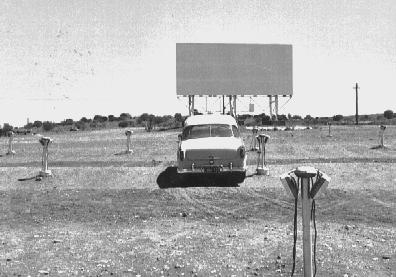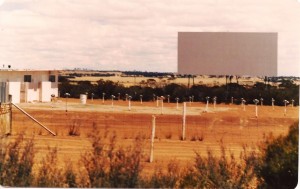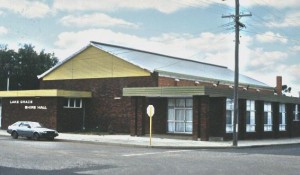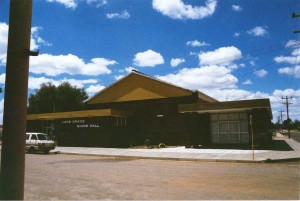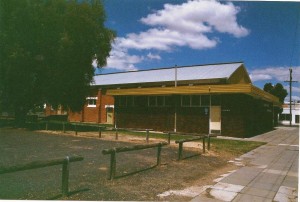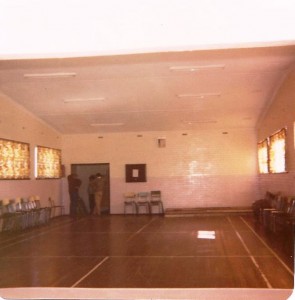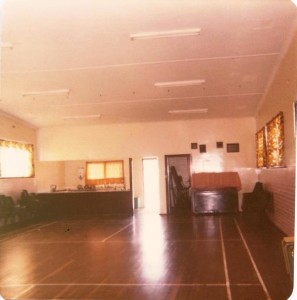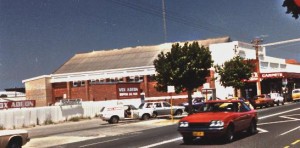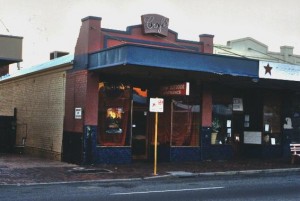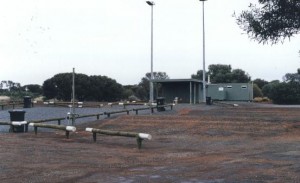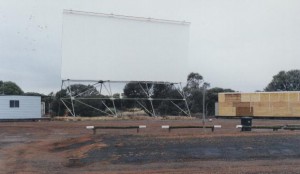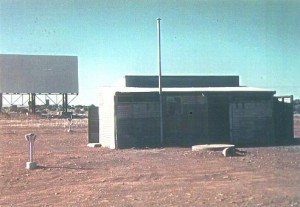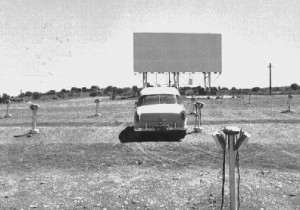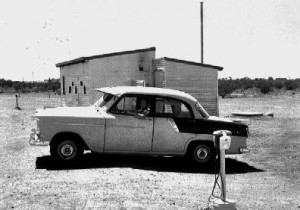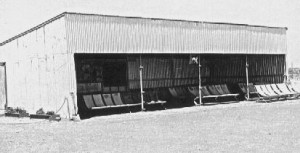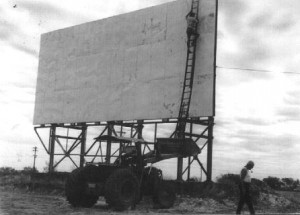Quicklinks
| Lake Grace | Lake King | Lancelin |
| Laverton | Lawlers | Leederville |
| Leinster | Leonora |
LAKE GRACE
HILLCREST DRIVE-IN, Stubbs Rd, Lake Grace
Laurie Thiel, who was screening in the Lake Grace Hall, purchased forty acres of freehold land from P.E.Trevennen, east of the town, on the north side of Stubbs St. Part of this was acquired for the new road, so the final size of the drive-in site was 23 acres. The land had been used as a rubbish dump, so while the drive-in was being planned an old carbody was left overturned on the corner of the site, the slogan ´Site of proposed drive-in, rubbish dumpers keep out’ visible from the highway.
The drive-in was then built, on a hill, with the screen at the lowest point, mounted on a ´tabernacle’ so it could be lowered for painting. The capacity was extended three times: from 160 cars to 180 cars, and finally to 230 cars. There was no playground, but the bio-box/concession building was large and well-equipped.
Lyn & Ann Parker bought the drive-in from Laurie Thiel in April 1977. They screened three or four nights each week at first, but as the effects of television and video were felt, this dropped back to twice a week. The young men of the town used to gather in the back rows on either side – one left the back seat of a car there permanently as a seat. Rowdy behaviour included setting off skyrockets from the top of the screen, and poking backsides over the top of the screen onto the image. Sunday was a good night, because all the sports matches were on Sunday afternoon: people then came to the drive-in, had dinner there and stayed on for the film. Also, the hotel closed at 7 on a Sunday, and the lights of cars could be seen coming up the hill immediately after 7 p.m. The Parkers ran the drive-in till 1986, then demolished the screen and converted the concession building into a house.
Some time after the drive-in closed, Lyn Parker again briefly screened films in the town: in 1987-8, he mounted a projector on a trailer and showed films in the football pavilion, screening through windows from under the verandah.
But in 1997 all film screenings in the town had ceased.
Sources: Film Weekly Directory 1964/5 – 1971
Public Health Department, building permit, Battye 1459
Max Bell, Perth – a cinema history, The Book Guild, Lewes, Sussex, 1986, p.136
Wagin Argus, 28 January 1965
Informants: Lyn Parker (1997), Alan Thiel (1997)
Photos: 1 exterior, colour, 1980’s, Max Bell
TOWN HALL, Bennett St, Lake Grace
/p>
An old photo in Rosie’s Cafe in the main street of Lake Grace shows a crowd outside the original timber hall which stood where the CWA hall now stands: it is not clear when this was built or whether it was ever used for films. The foundation stone for the new Lake Grace Road Board Hall on the north-east corner of the junction of Bennett and McMahon Sts, was laid on 29 November 1929, and there is a photo of this also on Rosie’s wall. It shows a substantial stone building with an attractive facade and a bio-box clearly evident above the flat section at the front of the hall: this front section, including the bio-box, was removed in a later renovation.
Screenings by travelling showmen in the Lake Grace hall were conducted from 1930 by a Mr Stevens, from before 1940 to about 1946 by J. A. (Jack) Wilson, then by Vince Lucas to about 1952. Wilson and Lucas both travelled in an ex-army ´pie truck’, in a circuit that included Kukerin and Newdegate. After this, L. F. (Laurie) Thiel began permanent screenings: he put in an acoustic ceiling at the back of the hall and installed projectors in the bio-box. The hall was not heated: in winter it was so cold that people brought rugs. Thiel screened on Saturday and Sunday nights each week, and sometimes Friday: a different programme was shown on Wednesday night.
Screenings ceased when the Hillcrest Drive-in opened in 1965.
Sources: Film Weekly Directory 1940/41 – 1964/5
Max Bell, Perth – a cinema history, The Book Guild, Lewes, Sussex, 1986, p.113
Informants: Lyn Parker (1997), Alan Thiel (1997)
Photos: 1 exterior, b&w, n.d. (on wall of Rosie’s cafe)
1 exterior, colour, 1997, Graeme Bertrand
2 exterior, colour, 1998, Roy Mudge
1 interior, colour, 1998, Roy Mudge
LAKE KING
HALL, Lake King
The Lake King hall stands next to the primary school, near the road from Newdegate. It is a small, timber building in excellent repair, with the exhaust pipe for a bio-box clearly visible above the facade. There is no foundation stone to give information about its origins.
Bart Mott operated his travelling picture circuit as far south as Hyden and Lake King, but it is not clear when he started or finished.
Photo: 1 exterior, colour, 1997, Graeme Bertrand
LANCELIN
HALL, Lancelin
In the late sixties, John Marsden was working six nights a week at the Windsor, and screening on Sundays on his own behalf. He tried various towns, including Capel, Brunswick Junction and Dwellingup, before shifting to Lancelin, where he transformed a room into a bio-box, put portables into it, and started screening in summertime. After some time, he closed here and moved on to Gingin.
Sources: Film Weekly Directory 1968/9 – 1969/70
Interview (Ina Bertrand): John Marsden (1997)
Photos: 2 interior, colour, 1981,Roy Mudge
LAVERTON
TOWN HALL AND GARDENS, Laver St, Laverton
Laverton was another boom town of the eastern goldfields, reaching a peak of prosperity around 1913-15, with several thousand residents. So many enlisted during World War 1, that the whole district slipped back, fragmenting, while the population gathered around the individual mine sites (Lancefield, Ida H, etc). The town prospered again between the wars, as the smaller settlements gradually disappeared, but it had once again declined by the 1950s to about 120 residents. The third boom occurred with the discovery of nickel at Windarra in 1969: Poseidon shares rose and fell, but the mine continued for twenty years until the nickel ran out, then the company continued to process ore (both nickel and gold) from other areas. Little of the old town remained by then, so Western Mining demolished what was beyond repair and built new homes and facilities.
The first Laverton hall was built in Laver St, diagonally opposite the main hotel. It was about 60ft long and 40ft wide, built of corrugated iron over a timber frame, and with a jarrah floor. In later years it was lined with timber to about 3ft high and caneite panels above that, and had a caneite ceiling. The acoustics were excellent, and a piano was kept on the stage. The bio-box was built on poles outside and above the entrance, and the screen was on the stage at the far end of the hall: behind the stage were the kitchens, with entry by outside stairs.
There were big doors in the middle of each side wall of the hall: those on the south side gave entry to the picture gardens, which ran at right angles to the hall. There may have been a bio-box in the north-east corner, beside the door from the hall: the gardens screen was across the south wall. Seating in the gardens was on individual or double deck chairs – some longer decks were kept around the sides of the hall, which was used for other community activities such as dances and balls.
The earliest screenings in the town may have been those of the Salvation Army Limelight Department, which visited in October 1902 and November 1904. But the Laverton hall and gardens, each holding 250, were not opened for regular screenings by Consolidated Theatres till 1935 or 1936. Their screenings, probably managed by Abe Pinder, took place one night each week until about 1948, then the gardens seems to have closed, but screenings in the hall were taken over by L.J. (Link) Sullivan till 1951/2, then by A.D. (Alf) Peterson. Picture night in the 30s and 40s was Thursday, which was also mail day – the day when the train arrived from Kalgoorlie. In the 50s pictures were on Saturday nights, and may have become less regular as the population declined, till screenings ceased in 1961.
When the town was resurrected in 1970, there was no sign left of the gardens, but the Laverton hall was shifted to the present school yard: it burned down a few years later, so there is now no sign of any picture venue in the town.
Sources: Film Weekly Directory 1940/41 – 1960/61
MPDA files 1942
Interviews (Ina Bertrand): R.Yelland (1985), Maureen & Peter Hill (1999)
Limelight Picture Show Tours, http//:www.abc.net.au/limelight/docs/tours
LAWLERS
HALL, Lawlers
This tiny settlement near Agnew had an exhibitor only briefly: the Film Weekly Directory of 1940/41 lists A.D.Peterson screening in the Lawless [sic] hall, holding 150. Alf Peterson certainly screened more extensively in other parts of this district – at first in Agnew (before the war), then after the war in Agnew, Leonora, Laverton, and Gwalia.
Nothing now remains of the old township of Lawlers, except one house now used by the Lawlers Gold Mine, and the cemetery. The only people living there are the mine workers, living in transportables on the minesite.
Sources: Film Weekly Directory 1940/41
LEEDERVILLE
EMPIRE AND GARDENS , 115 Cambridge St, Leederville
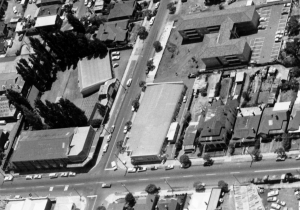
The first films in Leederville may have been screenings by the Salvation Army Biorama Company in September 1902, February 1904 and November 1904. Then Bartlett’s Electric Biograph and Blind Entertainers performed at the Masonic Hall in February 1907. But the first regular screenings seem to have been those of Empire Pictures, which began in May 1909 at the Mechanics Institute. By the summer of 1914-15 they also ran a gardens next to the Town Hall, and screened in the Town Hall during winter. In 1917 they opened new premises in Cambridge St. – a gardens next to the hall and bowling green at No.62, on the north side of the street, where The World’s Pictures had screened briefly in January 1913. They continued to screen in the Town Hall in wet or cold weather.
Then in 1928 Empire Pictures built a theatre and gardens on the south side, between Kimberley St and Northwood St, and closed the old gardens. The theatre fronted onto Cambridge St, and shared a bio-box with the new gardens, which was built behind the theatre, with the screen on the back wall along the Railway Pde fence. Entrance to the gardens was down a laneway on the east side of the theatre.
In the forties the theatre and gardens each held 800 and were part of the Hatfields Pictures circuit. In August 1958 the theatre was badly damaged by fire, and ceased screening. Shortly after, the premises were purchased by Vox Adeon, but for many years afterwards the red-brick bio-box could still be seen in the car park, on the site of the old gardens.
Sources: Max Bell, Perth – a cinema history, The Book Guild, Lewes, Sussex, 1986, pp.25, 58
Daily News, 13 August 1958
Film Weekly Directory, 1943/4 – 1960/61
Post Office Directory, 1918 – 1949
West Australian, 16 February 1907; 1909 – 1958
West Australian News, 25 November 1958
Interview (Ina Bertrand): Colin Hatfield (1997)
Photo: 1 exterior, colour, 1981 (Bill Turner)
1 aerial view, n.d. from the AMMPT archives
RIALTO GARDENS/ NEW OXFORD THEATRE and NEW OXFORD ARDEN BEAUTIFUL/ MANTRA’S NICKELODEON/ OLYMPIA/ NEW OXFORD/ STAR/ LUNA TWIN/ LUNA OUTDOOR CINEMA, 155 Oxford St, Leederville
Bill (Bunger) Bellion had screened on the Leederville Oval, and then had opened the Rialto Gardens in Newcastle St in 1926. In 1927 he became manager of the New Oxford theatre, built for E.A.Allwood on the north-west corner of the intersection of Oxford and Vincent Streets, opposite the Leederville Post Office. One feature of his early management of the theatre was special celebrations of the anniversary of the opening. The second anniversary celebration on 6 March 1929 was reported like this:
´Bunger’ Bellion put on a stage band, small ballet, and gave away 25 prizes of varying value and interest. Hundreds were turned away, and this enterprising showman is consequently repeating the idea tomorrow night. (Everyone’s 20 March 1929, p.37)
A Raycophone sound system was installed and talkies were first presented on 30 September 1929.
Bellion continued for a short while to operate the New Oxford Theatre in tandem with the Rialto Gardens. Then he closed that gardens, and in 1935 the New Oxford Garden Beautiful opened, at 669 Newcastle St, on the southern corner of the intersection of Oxford and Newcastle Streets. At that time, the gardens was one of the largest in the state, accommodating nearly 3000 people, in an environment which earned its name. In the forties the gardens held 2000 and the theatre around 1200.
In 1959, the premises were sold to Ampol Petroleum, which converted the gardens site into a service station. The theatre, however, continued to function till 1968. In 1971 it was re-opened as Mantra’s Nickelodeon, for one year, with a capacity reduced to 700. In 1972 and 1973 it reverted to the name Oxford, then in 1974 it re-opened as the Olympia, screening foreign-language films, such as Italian films in early 1978 and Chinese in mid-1978. In 1980 it reverted to its original name and was refurbished with assistance from the State Government for use by the Festival of Perth. 300 new upholstered seats replaced those in the circle, and the old circle seats went downstairs to replace most of the wooden stalls seats.
In 1982 the theatre was twinned, with Cinema 2, seating 150 patrons, constructed inside the former lounge foyer. From 1981 -6, during the day the Oxford 2 became the Star Cinema, an adult cinema, offering continuous screenings and live striptease, Monday to Saturday from 10.15 a.m. to 5.15 p.m. advertised separately from the Oxford, but clearly the same venue, ´opposite Leederville Post Office’. A record-breaking season of The Gods Must be Crazy in Cinema 1 in 1986-7 enabled the lessees (Cyril Watson and Roger Hunt) to purchase the theatre, and give it general maintenance and repainting. In 1988-9, Cinema 2 was renovated, the floor raised to improve sightlines, new aisle lighting installed and the ceiling insulated. Further renovations occurred in 1991 (mainly in Cinema 2) and in 1992 the whole building was painted inside and out, and further renovations included a new screen and ticket box and the restoration of the circle.
In 1995 Max Bell reported:
New Oxford, Leederville, taken over by Valhalla (Melbourne) Group and Lumiere (Perth) and renamed Luna Twin. Theatre entrance and foyer changed, new carpet installed, new smaller candy bar. Indirect lighting replaced older style lighting and chandeliers in the foyer. Cinema 2’s screen moved back to increase seating to nearly 200. Cinema 1 has new blue curtains. 70mm to be installed in the main cinema… New picture gardens opened nearby in Oxford St, Leederville, called Luna Gardens in the Park. Very basic, canvas deckchairs, portable bio box, large screen and Dolby surround sound system… (Kino, no.51, p.31)
The following year he reported that the Luna Open Air Gardens had moved from the school grounds to Leederville Oval, bringing the history of the venue full circle to Bunger Bellion before World War 1! However, a new Luna Gardens was opened on 26 December 1996, entrance through a shopfront in Oxford St, beside the theatre. When the gardens re-opened for the 1997-8 summer season, the entrance had been again re-located, through the former candy bar.
In 1999, it was reported that Coastal Cinemas (Fremantle) had joined with the Luna Cinemas Group, and that the Luna had been refurbished and re-opened, managed by Andrew Lippiat. Luna 2 was refurbished in 2000, with new carpets and wall drapes. Over the summer season of 2001-2, Luna Palace Cinemas operated the outdoor venue as Outdoor Next Door.
Sources: Public Health Department, building permit, Battye 1459
Max Bell, Perth – a cinema history, The Book Guild, Lewes, Sussex, 1986, pp.36-8, 61-2
Max Bell, ´New Oxford, Leederville’, Kino, no.39, March 1992, pp.14-15
Everyone’s, 7 March 1928, p.18; 18 April 1928, p.30; 16 January 1929, p.24; 20 March 1929, p.37; 18 September 1929, p.12; 12 February 1930, p.25
Film Weekly, 16 July 1959, p.9
Film Weekly Directory, 1943/5 – 1971
Kino, no.16, June 1986, p.23; no.19, March 1987, p.23; no.27, March 1989, p.23; no.35, March 1991, p.24; no.42, December 1992, p.32; no.43, March 1993, p.31; no.47, March 1994, p.31; no.49, September 1994, p.31; no.51, March 1995, p.31; no.55, March 1996, p.31; no.59, March 1997, p.31; no.60, June 1997, p.35; no.63, Autumn 1998, p.34; no.68, Winter 1999, p.35; no.73, Spring 2000, p.35
Post Office Directory, 1927 – 1949
West Australian, 1928 – 1982, 1999 – 2000
Interview (Ina Bertrand & Bill Turner)): Graham Norton (1981)
Interview (Ina Bertrand & Bill Turner): Jack Gynn (1981)
Interview (Hilton Lague): Reg Starr (1978)
Interview (Bill Turner): Alan Chester (1981)
Photos: 1 exterior, colour, 1981 (Bill Turner)
1 exterior (gardens site), colour, 1981 (Bill Turner)
1 exterior, b&w, Kino, no.39, March 1992, p.15 (L.R.Tod)
2 interior, b&w, Kino, no.39, March 1992, p.15 (L.R.Tod)
1 exterior, b&w, n.d. (Max Bell, Perth – a cinema history, p.61)
1 exterior (Luna twin), colour, 1997 (Graeme Bertrand)
1 exterior (Luna Outdoor entrance), colour, 1997 (Graeme Bertrand)
LEINSTER
LEINSTER DRIVE-IN AND OPEN AIR THEATRE, Worrung Rd, Leinster
The town of Leinster was built from scratch in 1977-8, for the workforce of Western Mining, and is still a company town. The drive-in was one of those facilities provided by the company to ease the difficulties of living so far from urban amenities. However, after a few years it had closed, and had become derelict.
In the mid-90s, Western Mining circulated community groups with an offer to upgrade the drive-in equipment if any group would run it: the Community Group tender was accepted. The Community Group is an incorporated body, formed in 1995 to raise money to provide facilities for the town. Western Mining kept their promise to upgrade facilities and the Community Group arranged for Ron Tutt to select and book the films and to organise their transport from Perth. The venue re-opened in October 1996, with a screening of Balto and Twister.
The Community Group runs the kiosk, and deputes another group (perhaps the Ambulance Service or something similar) to man the gate: profits are shared, and are used by the Community Group to provide facilities for the town, such as subsidising performances from Perth, or providing television sets in the transit houses where mine workers stay until their own furniture arrives from Perth. They also put money back into the venue, for instance spending about $15,000 in 1998, to upgrade sound (they have both radio and broadcast) and projection (replacing carbon arc light with zircon). They screen every two weeks in summer, about every 3-4 weeks in winter.
The venue has a large area in the middle of the field, enclosed
by low pole fencing, for seated patrons. These can bring their own seats, or they can hire one of the 100 deckchairs rented out by the Group. To one side is a grassed area, with a roofed section covering picnic tables and electric barbecues. Patrons can eat before a screening, or the area can be used for barbecues at other times: this is particularly useful to people living in the single quarters, who cannot have a party without disturbing the neighbours.
On (re-)opening night they provided a double feature and had 390 people (of 1,500 people in the town). They did very well at first, which meant plenty of money was raised, but were not doing so well by the middle of 1999 – about 150 people each screening. It takes 80 volunteer hours for each screening – collecting and returning film, making up the programme, working in the kiosk and on the gate, cleaning afterwards. Iain Dawson is manager and projectionist: he also is a secondary teacher, and as there are only a few teenagers in the town (maybe 10), he trains them in the projectionist booth.
Sources: Kino, no.58, December 1996, p.31
Informant: Trish Lynch (1999)
Photos: 2 exteriors, colour, 1999 (Graeme Bertrand)
LEONORA
FEDERAL & GARDENS/NEW FEDERAL & GARDENS/GLIDEAWAY, Tower St, Leonora
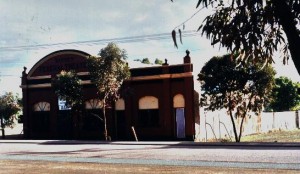
The townsite of Leonora was shifted three times, with the present site officially registered in April 1898, only a short distance from another townsite – Gwalia, built around the Sons of Gwalia goldmine. Leonora was gazetted as a municipality on 21 August 1900, and became the commercial capital of the district (perhaps because it was not dependent on a single mine). It boomed in the early years of the twentieth century, with a population reaching as high as 30,000. The Sons of Gwalia mine continued in production until 1963, so both towns survived much longer than some of those built around shorter-lived mines.
The first films screened in Leonora may have been those of the Salvation Army Biorama Company, which visited the town in October 1902, March 1904 and November 1904. There was also the Burns-Johnson fight, screened on Monday and Tuesday, 22 and 23 February, 1909. By April 1910 Wonderscope Pictures were advertising regular screenings in Leonora, presumably in the Federal Hall. This imposing stone structure with a brick facade had been opened in March 1901, in conjunction with Barnes’ Leonora Hotel (which had been built in 1896). It was located on the west side of the main street (Tower St), one building block south of Forrest St, and was used for most of the community activities in the town.
On 30 June 1910, the King of the West Picture Show exhibited films of the funeral of King George, only 54 days after the event took place in London, and by November that company (now known as Pride of the West) was exhibiting regularly, in the Federal Hall. This was probably a touring show, however, in December a local man (Harry Bradshaw of Gwalia) announced that he had purchased a projector and would be providing pictures in the Federal Hall (as well as Gwalia) in future, with Mr W. Fletcher as projectionist.
By January 1911, the main competition was between Bradshaw’s Excelsior company (screening in Gwalia) and the Olympia company (screening in Leonora), but the Excelsior was doing well enough to cause a fall in tram revenues, as fewer Gwalia people travelled to Leonora for the pictures. This may have been the time when Bradshaw took over the Gwalia operation, as by 1919 his company was screening in both towns. It seems likely that all the Leonora picture shows at the time were in the Federal Hall in winter, and in the Glideaway skating rink in summer, where Theatrescope Pictures (probably a new name for Bradshaw’s Excelsior Pictures) was advertising in January 1914.
Bradshaw’s name is remembered as the key picture show man for many years in Leonora, at least to 1920. He then relinquished his business to Peoples Pictures, a local Gwalia committee, set up by the Co-operative Stores, which screened at the Glideaway in Leonora on Tuesday evenings (as well as on Saturdays in Gwalia).
However, Bruce Barlow’s Wondergraph Pictures were advertised at the Federal Hall in August 1912, and Barlow remained the registered exhibitor in Leonora till 1936, when Bob Yelland’s Consolidated Pictures took over, possibly managed by Jim Schofield. The relationship between Barlow and Bradshaw is not clear – one possible explanation is that Barlow operated the Olympia company, and sold out to Bradshaw, but that Barlow’s name continued to be registered with Film Weekly as the exhibitor.
In 1946, Alf Peterson took over both the Leonora and the Gwalia venues, and by this time we know that in Leonora the Federal Hall was used in the winter and the gardens next door were used in the summer.
The Federal Hall, Leonora, was designed by Mr Will Kelly, who was described as ‘a talented comedian and dancer’. It was built of stone, with a brick facade, described in the Heritage Inventory thus:
The front elevation is painted tuck-pointed brickwork divided into bays by square pilasters that extend to a rendered parapet. The central section of the facade features a wide flat arched section that bears the name of the building, ‘Barne’s Federal Theatre’. The parapet conceals a gabled roof with four roof skylights along the ridge, and skillion roofs.
It had a wooden floor, a stage, and a bio-box inside the hall on poles above the entrance. The ranks of wooden seating had hinged seats that sprung up noisily whenever a member of the audience stood up. Films travelled to and from Perth by train, arriving on Tuesdays and Thursdays, in time for screenings on Wednesdays and Saturdays. The hall was unheated, so blankets and cushions were advisable for comfort.
Seating in the gardens was on deckchairs, and refreshments were supplied from the café further up the street, run by Alf Peterson and Beryl Demasson. The original gardens was next to the hall, then that was closed and replaced with another, on the east side of Tower St, two blocks up, between Trump and Rochester Streets. This move simplified the catering arrangements, at least when the pictures were in the gardens, as patrons could simply crossed the street for refreshments at interval. After any screening (hall or gardens, Gwalia and Leonora), the shop would be very busy right up till midnight, serving coffee, hamburgers, etc…
It was a comparatively simple matter to shift the gardens: both the old and the new venues were very basic, enclosed with a corrugated iron wall, and with a simple bio-box situated in the front wall. Either Alf Peterson or Ken Winter was projectionist at Leonora, while the other was projecting at Gwalia, and films were switched between the two venues. Peterson ran the Leonora hall and gardens till the drive-in was opened in 1960.
Sources: Shire of Leonora Municipal Inventory of Heritage Places, pp. 39-40
C.W.F.Turnbull (compiler), Gwalia-Leonora, Western Australia, 1895-1963, Leonora Tourist Committee 1990,
Film Weekly Directory 1940/41 – 1960/61
Kalgoorlie Miner 6 April 1910
Interviews (Colleen Pead): R.Yelland (1986), Alf Peterson(1986), Harold Morgan (1986)
Interview (Ina Bertrand): Beryl Demassen (1999)
Limelight Picture Show Tours, http//:www.abc.net.au/limelight/docs/tours
Photos: 1 exterior, b&w, n.d., Stage, Screen and Stars, West Australian, n.d. (1997?), p.47>
2 exteriors (Federal Hall), colour, 1999, Graeme Bertrand
SATELLITE DRIVE-IN, Sadie Canning Drive, Leonora
This drive-in was opened on the south-east corner of the junction of Sadie Canning Drive and the highway, on 1 March 1960 by Alf Peterson who had operated the New Federal Hall and Gardens. The decision to construct a drive-in was made in an effort to reduce the running around needed to keep venues in both Gwalia and Leonora operating, switching films between them.
The drive-in was called the ‘Satellite’ because it was so far outside the town, and because satellites were in the news at the time. Peterson did most of the construction himself, with assistance from various contractors, and using second-hand materials as far as possible, for economy. The metal for the screen supports came from an old mine being pulled down at Laverton, an electrician did the wiring, and Peterson put in the speaker stands himself, cementing each stand-pipe into a four-gallon drum let into the ground. He built a big corrugated iron shed, open on the long wall, with broadcast speakers mounted along the roof, and filled it with deckchairs for seated patrons. Food was served from a stall along the back of this shed. Cars entered the venue, were driven round the back of the shed, and a ticket collector stood there with a bag to collect the money: there was no ticket box and no fence of any kind, but the community was small and basically honest. The bio-box was free-standing in the middle of the ramps, with toilets on either end, the whole constructed again of (mostly second-hand) corrugated iron. At its peak, the venue screened three nights per week – Wednesday and Sunday (with the same film, for the benefit of the mine workers, who could not get to town in the middle of the week), and Saturday (with a different film). There was a free film screening for the children every Christmas and also at the time of the annual sports carnival, held on the flat area at the front of the ramps.
In its first season, the venue held sixty cars and one hundred seated patrons, and was very successful – full in hot weather and half full in cold weather. In 1971 the Film Weekly Directory listed its capacity as seventy cars and forty seated patrons. At its peak, it was a very popular venue, with most of the local population attending regularly and people driving in from the stations up to 70 kms away.
However, the Sons of Gwalia mine closed in 1964: the township of Gwalia virtually disappeared, and many people also left Leonora, till the combined population of the two towns was only 338 in 1966. The drive-in dropped back to one night per week (Sunday), and Alf Peterson considered looking for a picture show in Esperance, but after a few years the town came back (under the impetus of nickel discoveries and oil exploration) and the café was very busy so the drive-in stayed open till 1983. It was demolished in 1985, and the land (which had been leased from the Shire), was cleared before being passed back.
Sources: Film Weekly Directory 1960/61 – 1971
Public Health Department, Battye 1459
Max Bell, Perth, a cinema history, The Book Guild Ltd, Lewes, Sussex 1986, p.140
Daily News 22 August 1960
Interview (Colleen Pead): Alan Larkin (1986)
Interview (Ina Bertrand): Beryl Demasson (1999)
Photos: 2 exteriors, colour, n.d. (1980s?), Beryl Demasson
4 exteriors, b&w, n.d. (1960s?), Beryl Demasson

